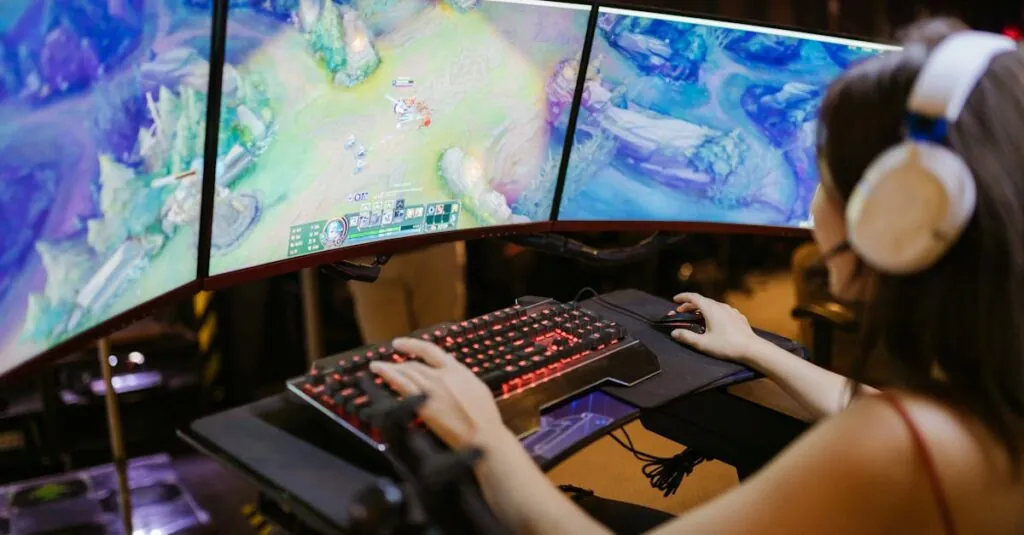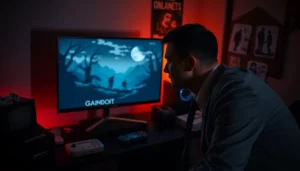Table of Contents
ToggleWhen the lights go out and the eerie sounds creep in, multiplayer horror games transform friends into frenemies, all in the name of survival. Imagine teaming up with your pals, only to find out that the real monster is lurking among you. These spine-chilling experiences not only test your courage but also your friendships, as trust becomes a rare commodity in the face of terror.
Overview Of Multiplayer Horror Games
Multiplayer horror games immerse players in terrifying environments where cooperation and strategy are essential. In these games, participants often assume different roles, such as survivors or killers, creating intense gameplay dynamics. High stakes elevate tension as players must rely on one another while confronting their fears.
Typically, players face numerous challenges, including hostile creatures and environmental dangers, that heighten the sense of dread. Well-designed soundscapes amplify the experience, producing unsettling noises that keep players alert. Classic titles like “Dead by Daylight” and “Phasmophobia” exemplify how fear can unite players against common threats.
Games in this genre encourage social interaction, turning friends into competitors. Tactical communication enhances gameplay, as shared information can mean the difference between life and death. Each session offers unique encounters, ensuring that no two games are alike. Drawing on teamwork, players often develop strategies to outsmart adversaries.
Statistics indicate that around 50% of gamers prefer multiplayer experiences, particularly in horror titles. Engaging narratives and immersive visuals contribute significantly to the popularity of these games. Many gamers appreciate the thrill of facing unknown horrors together, fostering strong camaraderie in the process.
This genre appeals to a wide audience, from casual gamers to committed fans of horror. Motivations for engaging with multiplayer horror games vary, with some seeking adrenaline rushes and others looking to strengthen social bonds. Each game adds a fresh twist to the horror formula, keeping players eager for more.
Popular Multiplayer Horror Games
Multiplayer horror games thrive on suspense and teamwork, immersing players in chilling scenarios. A variety of titles stand out for their engaging experiences and unique features.
Game 1: Dead by Daylight
“Dead by Daylight” pits four survivors against one killer in a game of cat and mouse. Survivors must work together to complete generators while the killer hunts them down. Various characters offer distinct abilities and challenges, enhancing gameplay depth. Maps change with each session, creating new strategies and dynamics. The game’s progression system allows players to unlock perks, enhancing survivability or hunting skills.
Game 2: Phasmophobia
“Phasmophobia” invites players to investigate haunted locations as a team of ghost hunters. Players can utilize tools like EMF readers and spirit boxes to identify paranormal activity. Unique ghost types offer different behaviors, requiring adaptive strategies and communication. VR support adds to the immersive environment, intensifying fear and surprise. The cooperative nature of this game encourages players to strategize, enhancing the tension of their ghostly encounters.
Game 3: Among Us
“Among Us” combines social deduction with horror elements, as crewmates work to complete tasks while impostors sabotage their efforts. Players must communicate effectively, pointing out suspicious activities without revealing their roles. The strategic discussions ignite paranoia and excitement, as trust gets tested. Unique settings and customizable characters add to the engagement. This game emphasizes deception, bringing a different type of fear to multiplayer horror.
Gameplay Mechanics In Multiplayer Horror Games
Multiplayer horror games thrive on their unique gameplay mechanics, balancing cooperation and competition to create intense experiences. Players often find themselves in roles that either require them to work together against the threatening environment or pit them against one another.
Cooperative Vs. Competitive Elements
Cooperative elements dominate the gameplay in many titles. Survivors in “Dead by Daylight” must rely on each other to escape the killer. Together, they create strategies to heal and rescue fallen teammates. Conversely, competitive elements emerge in titles like “Among Us,” where crewmates compete to identify impostors. Tension escalates as accusations and deceit unfold, forcing players to read each other’s behavior closely. Each game showcases a blend of these elements, enhancing excitement and immersing players in fear-driven scenarios.
Role of Communication
Effective communication plays a crucial role in multiplayer horror games. Players need to strategize and share information without revealing their positions to lurking threats. Voice chat facilitates real-time discussions, helping teams coordinate actions during critical moments. Non-verbal signals also become important; gestures or quick messages enhance teamwork under pressure. Games like “Phasmophobia” exemplify this, where players communicate to gather evidence and ensure their survival. Teams that communicate effectively often outperform those that rely solely on individual instincts, highlighting the necessity of collaboration in overcoming challenges.
The Impact Of Atmosphere And Sound Design
Atmosphere and sound design greatly influence the player’s experience in multiplayer horror games. Players often find that a well-crafted environment amplifies feelings of dread and suspense.
Building Tension Through Environment
Environments play a critical role in creating immersive horror scenarios. Dark corridors, unsettling visuals, and eerie landscapes evoke fear. Specific settings, such as abandoned hospitals or haunted forests, heighten players’ anxieties. Additionally, cleverly designed layouts often lead players into traps or unexpected confrontations with monsters. Players react strongly to these elements, as they cultivate an unsettling atmosphere that keeps them on edge. Environmental storytelling also enhances immersion. Subtle clues in the surroundings hint at past events, compelling players to explore further while bracing for danger.
Importance of Sound Effects
Sound effects significantly enhance the overall horror experience. Subtle noises, like distant whispers or creaking doors, maintain tension and alert players to impending danger. Players often rely on audio cues to anticipate threats, which intensifies the fear factor. Louder, jarring sounds can elicit immediate reactions, as sudden surprises catch players off guard. Moreover, silence can also be haunting, creating an anxiety-inducing atmosphere that sets the stage for horrifying encounters. Clear audio design enables players to strategize effectively, as they communicate and react to surrounding noises. Effective sound design ultimately positions itself as a vital component that elevates the horror experience in multiplayer games.
Multiplayer horror games offer a unique blend of fear and camaraderie that captivates players. They transform friendships into thrilling rivalries as gamers navigate terrifying scenarios together. The strategic elements and intense gameplay dynamics keep players engaged while fostering communication and teamwork.
As the genre continues to evolve, the appeal of these games remains strong. With immersive environments and innovative mechanics, players find themselves drawn into experiences that challenge both their bravery and their social bonds. Whether escaping a relentless killer or unraveling a ghostly mystery, multiplayer horror games deliver unforgettable moments that resonate long after the game ends.







